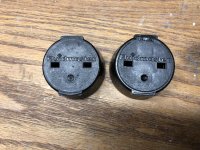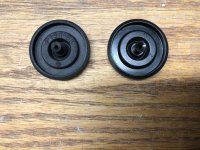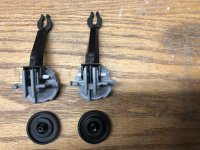OK, so here's what I have so far. "Official" auto fill valve on left, $7 Lowes toilet valve on right. Both are from FluidMaster. I obtained my 1st replacement auto-fill valve directly from the auto-fill manufacturer (
POOLMISER), for about $25, which matched exactly the one I replaced (they use FluidMaster). The first one probably lasted about 4-5 years, the second one about the same. The first one was subjected to my city's very hard water, the second one only had filtered, softened water run through it. Both have been subjected to up to 3500ppm saltwater, chlorinated. The current one is still in my pool, the one pictured is the first one I had.
I don't actually have any way to determine if Poolmiser is using the same type of valve you see for $35-40 (like Pentair's). Maybe they just use a cheap toilet valve. So that aspect of the comparison may fall short. Someone that buys the Pentair model will have to fill in the blanks here. But... if Amazon's photography is to be believed, the Pentair part is indeed FluidMaster, and looks to be absolutely identical in every way to the part I am replacing (except for the part that screws into the well).
The only noticeable difference between my old valve and the Lowes valve is the way the port for the toilet bowl filler tube is blocked in the Poolmiser version, where it is open in the Lowe's version. Other than that, the parts are all near-identical. Some of the markings are different, and the piece that screws into the well is slightly different, but functionally identical, as they each extends just as far. I disassembled both models. Identical. If the bladders are of different material, that is very likely the only possible difference. They have a different sheen to them, but one is been in the pool for five years! It would have been conclusive if they were marked identically, but the Poolmiser version has a part number, the Lowes version does not.
One thing of note, the black cap of the Lowes version specifically warns about adding chlorine to the toilet tank. "Ah ha!" I thought. So I checked the Poolmiser version and... it carries the same warning! But, to me, that only means FluidMaster is using the same part for both.
Since I am still inclined to change these out every year or two, I'm gunna unscientifically "pre-conclude" that the Lowe's model will be fine. Either way, I'll report back in Spring of 2024, unless it fails before then.
I don't think the thumbscrew adjuster of the Lowes model is going to fit in my well, as that part gets very near the underside of the well's cover. I'll either use the old one (they're interchangeable), or I'll just hacksaw off the thumbscrew and adjust it with some pliers. Note the bowl filler port is blocked in the Poolmiser version. This is the part that had different markings. The floats are identical, with the same part number. The part number on the float (400) is the entire valve's part number (not just the float's part number). But to me that doesn't mean much. You can definitely see how the chlorine affects the grey plastic.

The Lowes model seems to be date-stamped. It looks like "30-08-22."

One could definitely argue these are not made of the same stuff, but the one on the left has been in my pool for years.

The lever mechanism looks to be identical.

Here's the only other real difference between the two, but they'll both work exactly the same in my well.

I think there might be another gasket involved. Perhaps one inside the tubes somewhere. I couldn't get at that one, if it's there. But my future tests of either version will be performed by the flow indicator of a dedicated water meter, which will reveal the tiniest leak instantly, even if it can't determine what exactly is leaking or why. It's academic. If a $7 valve doesn't leak for two years, I'm good-to-go. If it does, then I'll pay the $40. Either way, I'll now know if and when they fail, because checking that water meter flow indicator is now part of my weekly routine.











